Planting techniques of Fructus Sophorae
Fructus Sophorae is a commonly used traditional Chinese medicine in China. It is the ripe fruit of Sophora japonica. Fructus Sophorae is an excellent hemostatic drug, which is often used to treat hemorrhoid bleeding, diarrhea, dysentery, hemoptysis and other diseases. Fructus Sophorae is widely planted in China, among which Henan, Tianjin, Shandong, Anhui and other places are the main producing areas. So what we need to know today is the planting technology of locust horn. Let's learn it together.

1. Land selection and preparation
It has the characteristics of dry and cold climate, light, fertilizer, cold resistance, drought resistance and strong adaptability to the environment. In order to improve the yield and quality of Huaijiao, we generally choose the land with sufficient sunshine, rich soil, strong permeability and perfect drainage and irrigation system to plant. Planting money needs to dig deep into the land, at least 60 centimeters, so mechanical arable land is usually used; basic fertilizer is applied, mainly circle fertilizer, combined with organic fertilizer and urea evenly; and finally rake flat and fine.
2. Planting method
The planting methods of Fructus Sophorae are generally two, namely sexual reproduction and asexual reproduction. Seed reproduction is sexual reproduction, generally sowing and raising seedlings in spring and autumn every year, and transplanting when the seedlings grow to a certain extent. Asexual reproduction is the use of root tillers for split propagation, according to the row spacing of two meters, plant spacing of 1.5 meters can be planted. On the other hand, seedling transplanting needs to be planted according to the distance of five meters between rows and four meters between plants. No matter which method is used for planting, we should apply ring fertilizer when planting, raise seedlings and plant, compact the ground after covering the soil, and water.
3. Field management
Field management is divided into seedling management and field management, while field management is divided into young tree management and adult tree management. Seedling management is inter-seedling, fixed seedling, topdressing and weeding and loosening soil, so as to promote the rapid growth of seedlings. The young tree period of field management is usually five years. In these five years, we only need timely watering, fertilization, weeding and pest prevention and pledge pruning, but there is no need to prune branches and leaves in the first two years. Five years later, we will manage according to the management of adult trees, which needs to be properly watered according to the degree of local climate drought, and scientific topdressing according to the different growth stages of Huaijiao.
4. Disease and pest control
The locust horn tree has strong resistance to diseases and insect pests, but this does not mean that it does not have the occurrence of diseases and insect pests. In general, the most common disease is canker, which mainly occurs in the seedling stage and just after transplanting, we can strengthen field management, scientific fertilization to improve the resistance of locust horn; the second is the use of lime, sulfur, salt, water in accordance with a certain proportion of the trunk coated on the tree trunk; of course, you can also use topiramate for spray. And locust horn more serious pests are locust inchworm, leaf moth, aphids, red spiders and so on, we can usually use dimethoate for poisoning, of course, we can also use deltamethrin or triclofenac to control.
The above is a brief introduction to the planting technology of Fructus Sophorae, of which the most basic condition is the environment of planting, and the most important is the field management technology of planting. As for the gold management technology of Huaijiao, the editor just introduced it to you here today. If you want to understand more specific management techniques, remember to pay attention to the next update of the editor.
- Prev

Culture methods and matters needing attention of threaded iron
1. Pot production standard: 14 cm basin, height 35 cm, crown width about 40 cm, listing period 7-8 months 2. Substrate preparation: add □ peat with loose, drained and ventilated Pinnell 5-40 mm peat and mix the peat with water. (standard: add water and mix well.
- Next

The proverb of growing flowers left to us by our ancestors
1. There is no need to explain, love flowers is the most flower-loving people. two。 To grow flowers, first to grow leaves, and to raise leaves first to raise roots. 3. Flowers are beautiful when they are watered with snow. 4. If it is not dry or watered, it must be thoroughly watered. 5. Fish water is fat, rice water is strong, and tap water is fine overnight. 6. If the rose is not pruned, there will be few flowers in the coming year. 7. Cut off the stalks of rose flowers
Related
- Fuxing push coffee new agricultural production and marketing class: lack of small-scale processing plants
- Jujube rice field leisure farm deep ploughing Yilan for five years to create a space for organic food and play
- Nongyu Farm-A trial of organic papaya for brave women with advanced technology
- Four points for attention in the prevention and control of diseases and insect pests of edible fungi
- How to add nutrient solution to Edible Fungi
- Is there any good way to control edible fungus mites?
- Open Inoculation Technology of Edible Fungi
- Is there any clever way to use fertilizer for edible fungus in winter?
- What agents are used to kill the pathogens of edible fungi in the mushroom shed?
- Rapid drying of Edible Fungi

